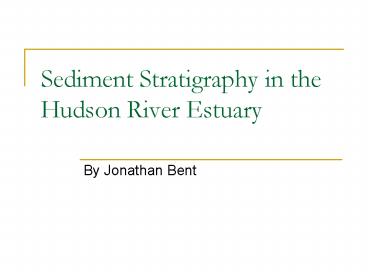Sediment Stratigraphy in the Hudson River Estuary - PowerPoint PPT Presentation
1 / 14
Title:
Sediment Stratigraphy in the Hudson River Estuary
Description:
The Hudson River Estuary is frequently dredged by the Army Corps of Engineers to ... Workers: Angela Slagle, Kristen Fountain, Robin Bell, George Lozefski, Nichole ... – PowerPoint PPT presentation
Number of Views:113
Avg rating:3.0/5.0
Title: Sediment Stratigraphy in the Hudson River Estuary
1
Sediment Stratigraphy in the Hudson River Estuary
- By Jonathan Bent
2
Background
- The Hudson River Estuary is frequently dredged by
the Army Corps of Engineers to allow deep-hulled
boats to travel and dock. - Hudson River cores have many anomalous layer
changes that might be explained by dredging, even
in areas said not to have been dredged.
3
The Core at Issue LWB1-13
Layer 1
Layer 2
Layer 3
Layer 4
- Issue The radical change at 45 cm seems to
suggest a cataclysmic event or anthropogenesis. - Feature of Interest The black intrusions from
45-60 cm, and the brown intrusions from 0-10 cm
seem to suggest a correlation of some sort
between the top of the core and the layer
boundary at 45 between layers 2 and 3. - Approach We must use pertinent proxies to
determine the cause (and approximate age if
possible) of this change
4
Thesis
- That there is a very strange and immediate color
boundary at 45 cm in LWB1-13. That we can
understand whether it is a natural boundary, or
the result of dredging by conducting several
proxies and tests. - Goal To prove that a) this boundary is the
result of dredging or b) that it is a natural
color transition that occurs when sediments age.
5
A Very Brief (Sorry!) Overview of Tests and
Proxies Conducted
6
Logging for Density
- Density seems to change at 40 cm.
- The slightly early jump may be due to machine
calibration error.
7
Magnetic Susceptibility Testing
- Magnetic Susceptibility usually indicates the
presence of brick dust and coal
slaganthropogenic elementsin the core. - Concentrations of these particles indicate
post-industrial sediments - Extremely high concentrations (over 50 units)
tend to indicate dredging boundaries, where brick
dust and slag have concentrated, perhaps after
precipitating preferentially from the disturbed
and then suspended sediments.
8
Cs-137 Testing
- The Cs-137 radionuclide is anthropogenic, the
result of nuclear fallout, and thus only exist in
sediment deposited since 1950s large-scale
nuclear testing. - Error bars taken into account, there is almost
certainly no Cs-137 at or below 60 cm. There is
plenty at 30 cm, so sediment from after 1950 must
start between 30 and 60 cm.
9
Loss-on-Ignition Testing
- Proxy to determine the amount by mass of organic
content in a sample - Entails
- Sampling a 2 cc portion of a core
- Weighing the wet sample
- Heating the sample to 100º C to boil off all
water - Reweighing the now dry sample
- Cooking the sample at 500-600º C for an hour to
burn off all organic matter - Reweighing the sample to determine mass lost upon
the ignition of the sample. - Organic content tends to decrease linearly in
cores, as bacteria and other microorganisms
consume and off-gas organic matter. If our
boundary is a dredging boundary, we might expect
to see a different, more dramatic, sort of change.
10
Loss-on-Ignition for LWB1-13
11
Bivalve Intrusions
- Bivalves burrow into the sediment and excrete
younger sediment into older, deeper sediment. - When material accretes at a standard rate and
little in the content of the sediment changes,
these burrow holes are almost invisible, as they
are compressed and similar in color. - Only at drastic or unnatural boundaries can these
holes can be seen because of the different nature
of the two juxtaposed sediments. - It is important to understand 2 transitions in
this animation a) that the very top olive-brown
layer always transitions to the black layer
beneath it quickly (gt5 years probably), and that
the black layer almost certainly changes to the
lowest gray/orange layer gradually over a long
period of time (gt200 years).
12
Results
- The dredging boundary in the density measurements
is very slightly off of the observed boundary. - The cessation of Cs-137 radionuclide emissions
could very well correlate with the dredging
boundary, but at least two more samples must be
taken to determine this without a doubt. - The change in the Magnetic Susceptibility and
Loss-On-Ignition graphs corresponds exactly with
the observed boundary.
13
Conclusions
- That because of leaps in density, organic
content, magnetizability and Cs-137 content, the
boundary that exists at 45 cm in LWB1-13 is
almost certainly unnatural and the result of
dredging. - That the similarity in length and size of the
bivalve intrusions likely show that the Layer 3
sediment as it is nownot as it was before
compaction and organic content losswas exposed
to benthic organisms. - That LOI testing is a good indicator of sediment
age and of the cause of layer boundaries. - That Army Corps of Engineers dredging records are
incomplete for this region.
14
Acknowledgements
- To my thesis mentor Bill Ryan
- To my thesis advisor Chris Scholz
- To Martin Stute
- To Dorothy Peteet and Tim Kenna for usage of
their equipment and labs. - Friends and Co-Workers Angela Slagle, Kristen
Fountain, Robin Bell, George Lozefski, Nichole
Anest, Chris Bertinato, Frank Nitsche































